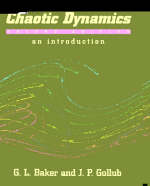
Chaotic Dynamics
An Introduction
Seiten
1996
|
2nd Revised edition
Cambridge University Press (Verlag)
978-0-521-47685-0 (ISBN)
Cambridge University Press (Verlag)
978-0-521-47685-0 (ISBN)
New edition of a very successful undergraduate text on chaos.
The previous edition of this text was the first to provide a quantitative introduction to chaos and nonlinear dynamics at undergraduate level. It was widely praised for the clarity of the writing and for the unique and effective way in which the authors presented the basic ideas. These same qualities characterise this revised and expanded second edition. Interest in chaotic dynamics has grown explosively in recent years. Applications to practically every scientific field have had far-reaching impact. As in the first edition, the authors present all the main features of chaotic dynamics using the damped, driven pendulum as the primary model. This second edition includes additional material on the analysis and characterisation of chaotic data, and applications of chaos. This new edition of Chaotic Dynamics can be used as a text for courses on chaos for physics and engineering students at the second and third year level.
The previous edition of this text was the first to provide a quantitative introduction to chaos and nonlinear dynamics at undergraduate level. It was widely praised for the clarity of the writing and for the unique and effective way in which the authors presented the basic ideas. These same qualities characterise this revised and expanded second edition. Interest in chaotic dynamics has grown explosively in recent years. Applications to practically every scientific field have had far-reaching impact. As in the first edition, the authors present all the main features of chaotic dynamics using the damped, driven pendulum as the primary model. This second edition includes additional material on the analysis and characterisation of chaotic data, and applications of chaos. This new edition of Chaotic Dynamics can be used as a text for courses on chaos for physics and engineering students at the second and third year level.
1. Introduction; 2. Some helpful tools; 3. Visualization of the pendulum's dynamics; 4. Toward an understanding of chaos; 5. The characterization of chaotic attractors; 6. Experimental characterization, prediction, and modification of chaotic states; 7. Chaos broadly applied; Further reading; Appendix A. Numerical integration – Runge-Kutta method; Appendix B. Computer program listings; References; Index.
| Erscheint lt. Verlag | 26.1.1996 |
|---|---|
| Zusatzinfo | Worked examples or Exercises; 3 Tables, unspecified; 2 Halftones, unspecified; 112 Line drawings, unspecified |
| Verlagsort | Cambridge |
| Sprache | englisch |
| Maße | 191 x 235 mm |
| Gewicht | 470 g |
| Themenwelt | Mathematik / Informatik ► Mathematik ► Analysis |
| Mathematik / Informatik ► Mathematik ► Angewandte Mathematik | |
| Naturwissenschaften ► Physik / Astronomie | |
| ISBN-10 | 0-521-47685-2 / 0521476852 |
| ISBN-13 | 978-0-521-47685-0 / 9780521476850 |
| Zustand | Neuware |
| Haben Sie eine Frage zum Produkt? |
Mehr entdecken
aus dem Bereich
aus dem Bereich
Buch | Softcover (2024)
De Gruyter Oldenbourg (Verlag)
59,95 €
Buch | Softcover (2024)
De Gruyter Oldenbourg (Verlag)
59,95 €


